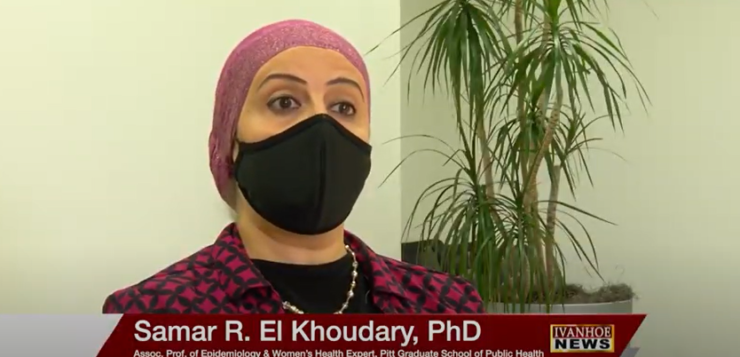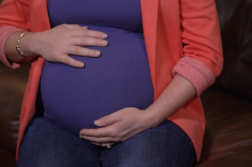Samar R. El Khoudary, PhD, MPH, Associate Professor of Epidemiology & Women’s Health Expert, University of Pittsburgh Graduate School of Public Health, talks about heart disease risk in menopausal women.
I wanted to start by asking you about your most recent study on heart disease risk and the adipose tissue, the fat around the abdomen during menopause.
EL KHOUDARY: Yeah. This was a unique study we have done as part of the study of women’s health across the nation, SWAN Heart ancillary study, where we enrolled 362 women at midlife, and we looked at the change in visceral fat, or the fat in the abdomen, as they transition through menopause and then link the change in this fat over the menopausal transition with risk for atherosclerosis in the carotid artery.
I know you said it was 362 women. How long did you follow them? How long were they in the study? And what were the age ranges? I mean you’re talking about was it 35 to 50 or?
EL KHOUDARY: So, women started in SWAN with the age of 42 to 51. However, within SWAN Heart we have the mean age about 51. This does not mean that all the women were postmenopausal. We have the majority of them in the transition and a proportion, I would say, like, 10 percent, postmenopausal. But then as part of the big study we have been following those women for over 25 years. The study started in 1996 to 1997 which means, you know, we followed them until all the participants become menopausal. Then we were able to go back and look at those women for whom we have measures of the visceral adiposity and have observed their final menstrual period and do this kind of unique analysis within the SWAN study.
For the purpose of this study, Doctor, can you describe for our viewers how you went about doing those measurements?
EL KHOUDARY: Visceral fat, there are different ways really to measure visceral fat. I would say at the research level we prefer to do that using CT scan where we actually get, like, a scan at the level of the abdomen where we measure the area of the visceral fat within the abdomen. Now, there are other ways, less expensive, that can give you an idea if you have that kind of visceral fat using just, you know, the waist circumference. And, based on the American Heart Association and other organizations, we know, for example, that if you have a waist circumference that is greater than 88 centimeters or 35 inches this mean that you have that kind of abdominal adiposity. And it’s an indication of visceral fat in the abdomen.
So even just something as simple as a tape measure? Those numbers can make a difference?
EL KHOUDARY: Absolutely. That’s one way each of us women can just stand in front of the mirror and take that measure and know where she stands about this important vital sign that, you know, they may experience at midlife.
Back to your study, what did you find when you were looking at those numbers?
EL KHOUDARY: So, as I mentioned, we looked at the change in visceral adiposity as women transition over menopause. And we were able to identify the time point at which women start to accumulate the fat in the abdomen. In particular, women start to accumulate two years before their final menstrual period. We identify that women can accumulate up to an 8.5% increase in visceral fat. And then there is another increase but that is less than what happened during this period happening after menopause. So, we were able to show an acceleration in visceral fat accumulation starting two years before menopause.
Did weight make a difference? Did those women gain a lot of weight? Or was it more a shifting… everything seemed to settle in the middle?
EL KHOUDARY: So that’s a very interesting question. We know that, you know, as we go through menopause there is an increase in weight. Studies so far have showed that increasing weight in general is more of an aging process. But the shift in the fat and coming in the abdomen is more a menopause-related phenomenon. So that’s something you expect to happen, and it’s related to menopause. And there has been research suggesting that it could be driven by the hormonal changes happen as we transition through menopause.
What did you find when women had this larger circumference or had this extra fat deposited there? What was their additional risk?
EL KHOUDARY: So, the additional work we have, I would say, a unique contribution this paper was provided in addition to specifically show that increase happening two years before menopause, that this increase happening during this period in particular, puts women at higher risk of developing carotid atherosclerosis. We, in previous studies, showed also that women at midlife have an increase in the thickness of the carotid artery. So, you know, now we kind of put our hand on one potential, you know, factor that could contribute to this. And we may be able to intervene on this factor.
What are the implications for both women and their doctors from this study?
EL KHOUDARY: I think the implication is really very significant. Number one, we want to make sure that women are aware that the midlife and the menopausal transition is not just a period where they have, you know, experience vasomotor symptoms, hot flashes and other, you know, symptoms like maybe sleep disturbance, but also menopause matters when it comes to cardiovascular health. And knowing that women, as they transition through menopause, start to accumulate more fat in their abdomen, this fat is known to be really risky fat, it’s critical for women to monitor, you know, that kind of fat happening. And to heart care health care provider also, you know, help her by, you know, monitoring that. And, if needed, intervene on that by suggesting some sort of lifestyle changes that, you know, we keep stressing on it because really, it’s working.
I was going to ask you if a woman notices and measures and sees that increase what are her next steps? Obviously, discussions with doctors?
EL KHOUDARY: Absolutely. She should discuss with her doctor all the implications related to increased visceral fat or the abdominal adiposity that she is experiencing. And right away, you know, by contacting or discussing with her clinical doctor there could be an easy way, really, to intervene on this. I would say research so far showed us that diet plus exercise or without exercise can help reduce this visceral fat. So, some additional changes in lifestyle may prevent her from going through having higher risk for atherosclerosis in the future.
Doctor, if you could tell me again. Where was this published? And also, you were part of a committee that looked at a statement for the heart. I think it was the heart association last year, right?
EL KHOUDARY: Yes. Yes. So, this paper was published in the journal Menopause, the premiere journal for the North American Menopause Society. And it was, actually, at the same time we were working on the first scientific statement on menopause and cardiovascular disease, which really summarized a huge amount of literature that has been accumulated marking the menopausal transition as an important and critical stage of women’s lives when it comes to heart health and cardiovascular health.
Is there anything I didn’t ask you that you would want to make sure that people know?
EL KHOUDARY: I think the main thing I want all people to know is that this period of a woman’s life is important. It’s not just about visceral fat. Visceral fat is another indicator that we have been seeing change as women transition through menopause. During the same time frame, women have changes in their lipids. Women have a higher increase in metabolic syndrome, which is a syndrome that has a combination of multiple risk factors. And we also know that the health of the vasculature changes during this period. So, when you look at this picture all together, it means that we have to be very careful. We have to apply a healthy lifestyle. If we have never done that, it’s really that time for women to adapt to such a healthy lifestyle at this stage of her life.
I’m just going to check my notes really quick and see if there’s anything I wanted to ask you. I think I did ask but I’m going to ask it one more time. Is there a percentage increase that becomes more of a risk factor? Did you notice of the 362 what percent of women were in that higher risk category?
EL KHOUDARY: When we looked at this, really, we looked at the continuous scale measure making us not specifically getting how many of the participants get that. But it’s more of unraveling an association that exists over the transition. The way I will interpret this, or put it in a perspective, is by looking again at simple measure, like waist circumference, and see if I am above the cut point — this means that I am experiencing an increase in the visceral fat. And I could be at risk of early marker of atherosclerosis.
Is there a measure, I mean should it be at belly button or is it about two inches below belly button?
EL KHOUDARY: So, there are two ways of measuring waist circumference. You may get it at the top of the hip, or what we call the iliac crest, or between the top of the hip and the lower rib in the middle. That’s where you have to use the tape. And both of them are valid, you know, ways to measure waist circumstance.
And again, greater than 35 inches on one of those measurements could be an indication that there might be accumulation.
EL KHOUDARY: Absolutely.
Interview conducted by Ivanhoe Broadcast News.
END OF INTERVIEW
This information is intended for additional research purposes only. It is not to be used as a prescription or advice from Ivanhoe Broadcast News, Inc. or any medical professional interviewed. Ivanhoe Broadcast News, Inc. assumes no responsibility for the depth or accuracy of physician statements. Procedures or medicines apply to different people and medical factors; always consult your physician on medical matters.
If you would like more information, please contact:
ALLISON HYDZIK
412-600-6049
Sign up for a free weekly e-mail on Medical Breakthroughs called First to Know by clicking here




